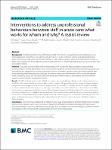Interventions to address unprofessional behaviours between staff in acute care: what works for whom and why? A realist review
| dc.contributor.author | Maben, J | |
| dc.contributor.author | Aunger, JA | |
| dc.contributor.author | Abrams, R | |
| dc.contributor.author | Wright, JM | |
| dc.contributor.author | Pearson, M | |
| dc.contributor.author | Westbrook, JI | |
| dc.contributor.author | Jones, A | |
| dc.contributor.author | Mannion, R | |
| dc.date.accessioned | 2023-10-31T20:43:35Z | |
| dc.date.available | 2023-10-31T20:43:35Z | |
| dc.date.issued | 2023-10-31 | |
| dc.identifier.issn | 1741-7015 | |
| dc.identifier.issn | 1741-7015 | |
| dc.identifier.other | 403 | |
| dc.identifier.uri | https://pearl.plymouth.ac.uk/handle/10026.1/21497 | |
| dc.description.abstract |
Background Unprofessional behaviour (UB) between staff encompasses various behaviours, including incivility, microaggressions, harassment, and bullying. UB is pervasive in acute healthcare settings and disproportionately impacts minoritised staff. UB has detrimental effects on staff wellbeing, patient safety and organisational resources. While interventions have been implemented to mitigate UB, there is limited understanding of how and why they may work and for whom. Methods This study utilised a realist review methodology with stakeholder input to improve understanding of these complex context-dependent interventions. Initial programme theories were formulated drawing upon scoping searches and reports known to the study team. Purposive systematic searches were conducted to gather grey and published global literature from databases. Documents were selected if relevant to UB in acute care settings while considering rigour and relevance. Data were extracted from these reports, synthesised, and initial theories tested, to produce refined programme theories. Results Of 2977 deduplicated records, 148 full text reports were included with 42 reports describing interventions to address UB in acute healthcare settings. Interventions drew on 13 types of behaviour change strategies and were categorised into five types of intervention (1) single session (i.e. one off); (2) multiple session; (3) single or multiple sessions combined with other actions (e.g. training sessions plus a code of conduct); (4) professional accountability and reporting programmes and; (5) structured culture change interventions. We formulated 55 context-mechanism-outcome configurations to explain how, why, and when these interventions work. We identified twelve key dynamics to consider in intervention design, including importance of addressing systemic contributors, rebuilding trust in managers, and promoting a psychologically safe culture; fifteen implementation principles were identified to address these dynamics. Conclusions Interventions to address UB are still at an early stage of development, and their effectiveness to reduce UB and improve patient safety is unclear. Future interventions should incorporate knowledge from behavioural and implementation science to affect behaviour change; draw on multiple concurrent strategies to address systemic contributors to UB; and consider the undue burden of UB on minoritised groups. | |
| dc.format.extent | 403- | |
| dc.format.medium | Electronic | |
| dc.language | en | |
| dc.publisher | Springer Science and Business Media LLC | |
| dc.subject | Acute healthcare | |
| dc.subject | Bullying | |
| dc.subject | Incivility | |
| dc.subject | Organisational culture | |
| dc.subject | Patient safety | |
| dc.subject | Professionalism | |
| dc.subject | Psychological safety | |
| dc.subject | Psychological wellbeing | |
| dc.subject | Unprofessional behaviour | |
| dc.subject | Workforce | |
| dc.subject | Humans | |
| dc.subject | Delivery of Health Care | |
| dc.subject | Incivility | |
| dc.subject | Microaggression | |
| dc.subject | Harassment, Non-Sexual | |
| dc.subject | Bullying | |
| dc.subject | Workplace | |
| dc.title | Interventions to address unprofessional behaviours between staff in acute care: what works for whom and why? A realist review | |
| dc.type | journal-article | |
| dc.type | Journal Article | |
| dc.type | Research Support, Non-U.S. Gov't | |
| plymouth.author-url | https://www.ncbi.nlm.nih.gov/pubmed/37904186 | |
| plymouth.issue | 1 | |
| plymouth.volume | 21 | |
| plymouth.publication-status | Published online | |
| plymouth.journal | BMC Medicine | |
| dc.identifier.doi | 10.1186/s12916-023-03102-3 | |
| plymouth.organisational-group | |Plymouth | |
| plymouth.organisational-group | |Plymouth|Faculty of Health | |
| plymouth.organisational-group | |Plymouth|Faculty of Health|School of Nursing and Midwifery | |
| plymouth.organisational-group | |Plymouth|REF 2021 Researchers by UoA | |
| plymouth.organisational-group | |Plymouth|Users by role | |
| plymouth.organisational-group | |Plymouth|Users by role|Academics | |
| plymouth.organisational-group | |Plymouth|REF 2021 Researchers by UoA|UoA03 Allied Health Professions, Dentistry, Nursing and Pharmacy | |
| dc.publisher.place | England | |
| dcterms.dateAccepted | 2023-10-04 | |
| dc.date.updated | 2023-10-31T20:43:28Z | |
| dc.rights.embargodate | 2023-11-2 | |
| dc.identifier.eissn | 1741-7015 | |
| rioxxterms.versionofrecord | 10.1186/s12916-023-03102-3 |


